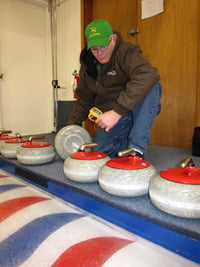
It's a game of ultimate precision played with 40-pound chunks of granite, where the tiniest changes in momentum and trajectory can bring victory... or defeat. And the success of every move starts and ends with the ice. It's got to measure up.
For Shawn Olesen and Quentin Way, volunteer ice technicians for USA Curling, creating the quality ice a successful curling competition demands can be a challenge—or an opportunity. It's all in how you see it.
Starting with a clean sheet
Curling doesn't happen without cold, so it's no surprise that home base for Olesen, Way, and USA Curling's Head Ice Technician, Dave Staveteig, is North Dakota.
Getting ready for a major curling competition, like the US Junior Championships at the Granite Curling Club in north Seattle, starts literally with a clean sheet... of ice.
What makes great ice? The goal is "consistency through the event," said Olesen, "so the players can call the shots they want to try and they don't have any reservations because of the conditions of the arena. You should be able to throw the same type of shot with the same amount of curl and speed in the first game versus the last game."
Olesen, Way, and Staveteig start several days before an event to paint the ice, flood on a fresh layer of water, and ensure the sheet is perfectly level. Water droplets are sprayed on the playing surface, where they freeze into "pebbles" that have two important jobs. As the sheet is leveled, the pebbles get shaved off the high spots, but remain visible to show where ice is low and more water is needed. When leveling is complete, fresh "game pebble" is sprayed on to help the stones glide smoothly and minimize drag.
Too damp? Too dry?
Making and maintaining quality ice is a multi-dimensional challenge. The facility's refrigeration system controls the ice sheet's temperature, but the technology and capacity of these systems can vary widely. When play begins and several dozen competitors start moving energetically up and down the sheet, they move air and generate heat. Anticipating this effect, the ice team will turn up the cooling system to maintain optimum ice temperatures.
Temperature is critical. Too warm means ice gets too soft; too cold is too brittle. Just right, according to Way, is 23.5 °F (-4.7 °C).
Managing air temperature and humidity is also vital. Ice acts like both a solid and a liquid; in some ways it is almost alive. It can move, grow (if frost gathers from moisture in the air) or, if the air is too dry, evaporate and shrink.
"We're always checking dew point, just to keep from building frost on the playing surface," said Olesen. "Temperature and humidity—if we can control it, we will."
The ideal dew point should match the ice surface temperature, said Way. "When you get down to the 18 degree [F] or zero degree dew points you're actually losing ice surface." When a facility's HVAC system can't deliver the right conditions—many northern facilities lack air conditioning to offset ambient heat—for the ice team, that's not cool.
"Your pebble can deteriorate and break down, then you're getting too much friction," said Olesen. "You can have frost problems, or the ice changes during the play." If ice temperature rose just one degree, ice quality could be destroyed by mid-game, Way added.
Conditions outdoors can make a difference inside. When outdoor temperatures drop to minus 20 °F (-6.6 °C) in Fargo, Way said, just opening the doors will help cool the building and the sheet. But if there's a wet snow outside, open doors could admit damp air and lead to frost problems.
Air distribution can be another challenge indoors. How many heaters are present, where they are, and how they direct air all make a difference at ice level. Some facilities send heat to the center of the sheet, while others direct it to one side. To understand how this might affect the game and make adjustments, it's essential for the ice techs to see what's happening.
Measuring up
Ice control is founded on measurement, so the ice techs log readings of air, ice, and coolant temperature and humidity throughout the competition.
"Five years ago there'd be one thermometer out in the middle of the rink," Olesen said, "and somebody'd have to walk out and check it every ten or fifteen minutes."
Go to PDF version of "A Slippery Slope? Not for Curling's Ice Technologists"